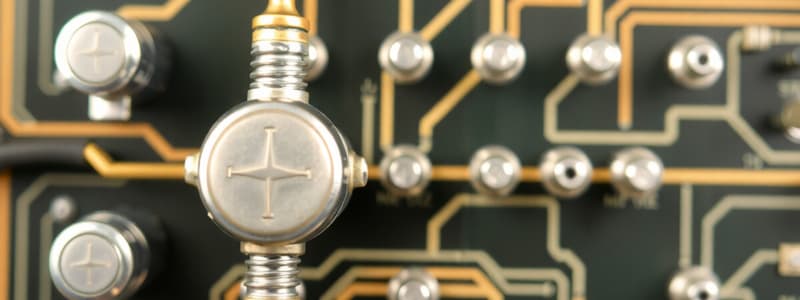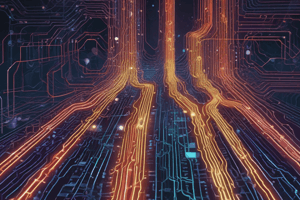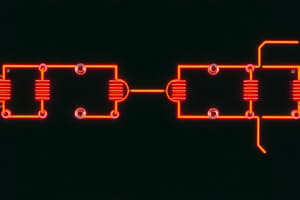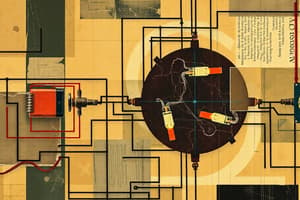Podcast
Questions and Answers
In a series circuit, how are components connected?
In a series circuit, how are components connected?
- Randomly, with no specific order.
- Directly to the power source.
- One after another, in a single loop. (correct)
- In branched pathways.
How many paths for electricity are there in a series circuit?
How many paths for electricity are there in a series circuit?
- Infinite paths.
- One path. (correct)
- No paths.
- Multiple paths.
What defines a parallel circuit?
What defines a parallel circuit?
- Components connected in a single loop.
- Components not connected at all.
- Components connected randomly.
- Each component connected in its own branch directly to the power source. (correct)
In a parallel circuit, a break in one branch will:
In a parallel circuit, a break in one branch will:
In a parallel circuit, the points where a loop branches off are called:
In a parallel circuit, the points where a loop branches off are called:
Which of the following is the same across each component in a parallel circuit?
Which of the following is the same across each component in a parallel circuit?
What happens to the total resistance in a parallel circuit when more components are added?
What happens to the total resistance in a parallel circuit when more components are added?
What does Ohm's Law describe?
What does Ohm's Law describe?
According to Ohm's Law, if voltage increases and resistance stays constant, what happens to the current?
According to Ohm's Law, if voltage increases and resistance stays constant, what happens to the current?
If the voltage in a circuit is 12V and the total resistance is 4 ohms, what is the current according to Ohm's Law?
If the voltage in a circuit is 12V and the total resistance is 4 ohms, what is the current according to Ohm's Law?
In a parallel circuit, what happens to the total current as it flows through each branch?
In a parallel circuit, what happens to the total current as it flows through each branch?
In a parallel circuit, if you add more resistors, what happens to the total current from the source?
In a parallel circuit, if you add more resistors, what happens to the total current from the source?
What is the mathematical representation of Ohm's Law?
What is the mathematical representation of Ohm's Law?
What is the effect on total resistance in a parallel circuit when additional components are added?
What is the effect on total resistance in a parallel circuit when additional components are added?
In a parallel circuit with a voltage source of 2V, what is the voltage across each resistor?
In a parallel circuit with a voltage source of 2V, what is the voltage across each resistor?
Flashcards
Series Circuit
Series Circuit
Connects components one after another in a single loop, providing only one path for current flow.
Parallel Circuit
Parallel Circuit
Connects components in separate branches, allowing multiple paths for current flow.
Node
Node
A point in a parallel circuit where the current divides and flows through different branches.
Voltage in Parallel Circuits
Voltage in Parallel Circuits
Signup and view all the flashcards
Current in Parallel Circuits
Current in Parallel Circuits
Signup and view all the flashcards
Ohm's Law
Ohm's Law
Signup and view all the flashcards
Resistance in Parallel Circuits
Resistance in Parallel Circuits
Signup and view all the flashcards
Study Notes
- Electrical circuits have two basic configurations: series and parallel.
- Series circuits connect devices in a row, one after another.
- Parallel circuits connect devices in branched pathways.
Series Circuit
- Components are connected consecutively in one loop.
- Electricity flows through a single path.
Parallel Circuit
- Each component connects in its own branch directly to the electricity source.
- Provides multiple paths for electricity flow simultaneously.
- A break in one branch does not affect devices in other branches.
- Each component connects from both ends directly to the source, forming its own loop or branch.
- Each branching point of a loop is a node.
- Current flows from the voltage source through nodes to each component and back to the source.
- Some current flows through all components at the same time.
- A break in one branch does not affect other components.
Properties of Parallel Circuits: Current, Voltage, and Resistance
- Voltage across each component is the same.
- Current flow through each branch is not the same.
- Current divides at nodes and rejoins after passing through components, with the total current equaling the sum of current in each branch.
- Total resistance is less than the resistance of individual components.
- Additional components decrease total resistance.
Voltage in Parallel Circuits
- Voltage results from differences in electrical potential energy.
- In parallel circuits, each component is directly connected to the power source, so voltage at each component equals the source voltage.
Ohm's Law in a Simple Parallel Circuit
- Describes the relationship between voltage, current, and resistance.
- Current is directly proportional to voltage and inversely proportional to resistance.
- Increasing voltage increases current, and vice versa.
- Increasing resistance decreases current, and vice versa.
- Mathematical formula:
- To calculate current in a circuit with 9v and 3 resistance, I = 9/3 or 3 amps
Resistance in Parallel Circuits
- Resistance diminishes with each added component.
- Adding components increases nodes, reducing current flow through each branch, but total current is the sum of each branch's current.
- The formula
- This can be rearranged to be
Example
- In a circuit with 2V and resistors of 2, 3, and 6 ohms
- The total resistance is calculated as :
- Then using Ohms law to find current, I = V/R
Studying That Suits You
Use AI to generate personalized quizzes and flashcards to suit your learning preferences.




